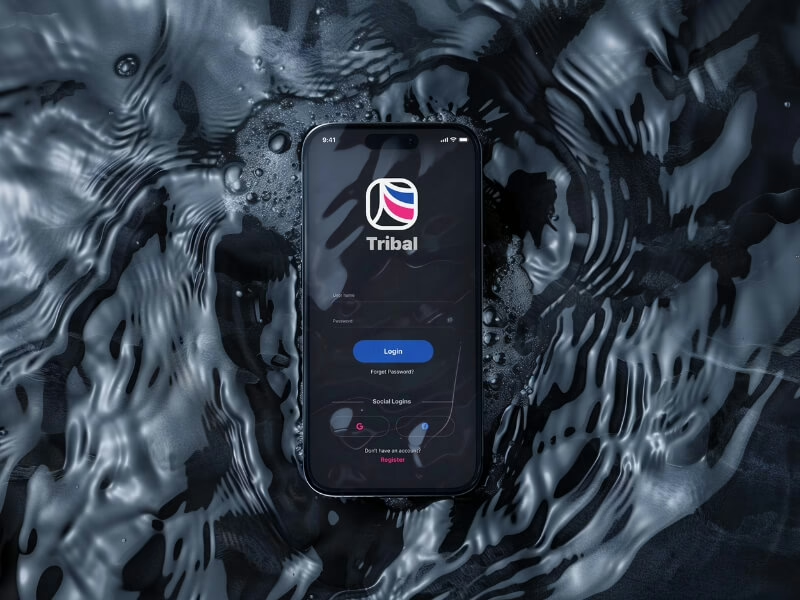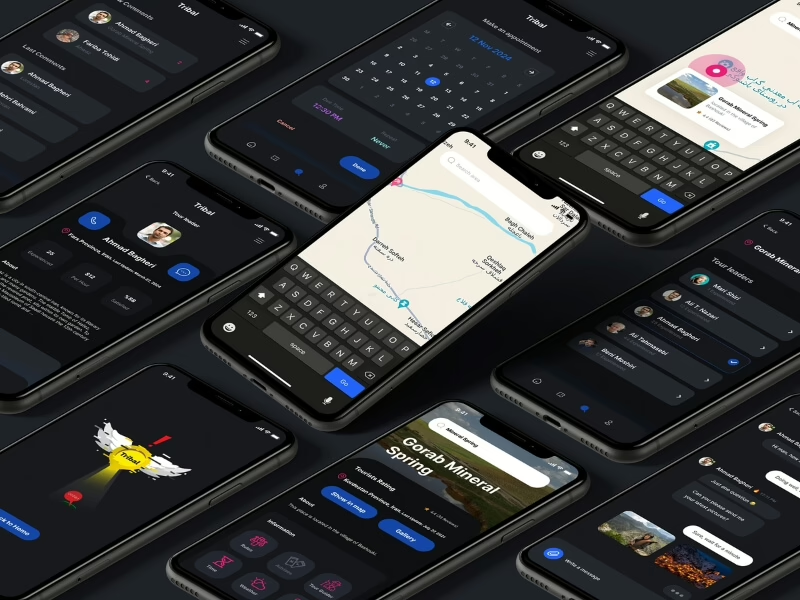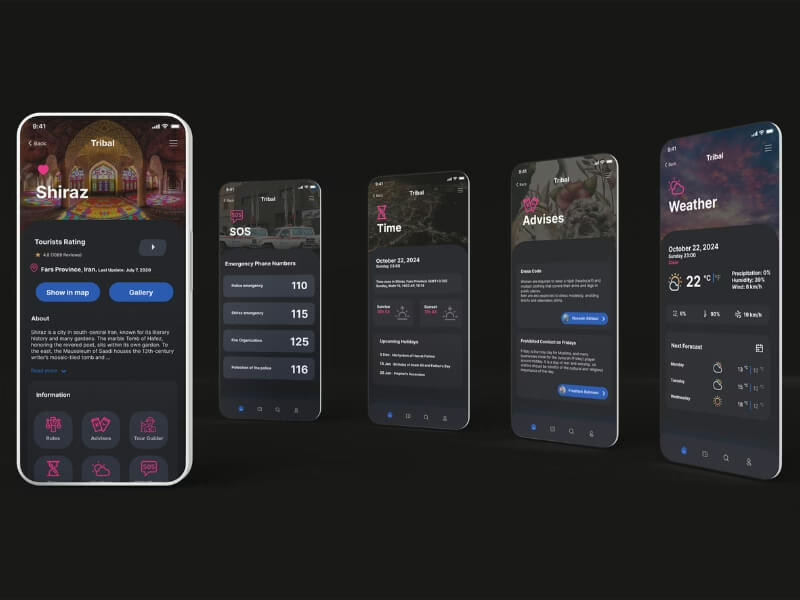Tribal reimagines Middle East travel by connecting tourists with local residents in off-the-beaten-path towns. Awarded Best-of-Best in User Experience Design (Student Category), UI/UX designer Fateme Mohammadi Maklavani shares how she built a sustainable platform to boost community jobs, overcome language barriers, and deliver reliable, up-to-date travel info.
Project Overview
Tribal addresses a gap in travel resources by linking visitors with local guides in smaller Middle Eastern towns. Anchored in the UN’s “Decent Work and Economic Growth” goal, the app promotes eco-tourism, real-time chat translation, and rich cultural storytelling, empowering communities while giving travelers an authentic experience.
Winning Project Title: Tribal
Winning Category: UI/UX (Best-of-Best, Student)
Lead Designer: Fateme Mohammadi Maklavani

Interview with Fateme Mohammadi Maklavani
1. How did you get started in design, and how has your work grown?
Fateme Mohammadi Maklavani: I started this project with one big question in mind: How can I create more job opportunities for local communities? Through conversations with different people and a lot of online research, I realized that most tourists visiting the Middle East, especially Iran, only see the well-known spots in major cities. Meanwhile, there are countless historical and cultural places hidden in smaller towns and villages that remain completely off the radar.
The deeper I looked, the more I saw a huge gap in reliable, up-to-date travel information. It was almost impossible for travelers to connect with local communities or access trustworthy resources. That’s what sparked the idea for Tribal – an app designed to bridge this gap by connecting tourists with local residents and providing essential travel information.

2. What was the brief or challenge, and what goals guided you?
Fateme Mohammadi Maklavani: This project was built around one of the United Nations’ key Sustainable Development Goals: Decent Work and Economic Growth. The core idea was to create fair and sustainable job opportunities, especially in regions where economic growth has been slow.
In many Middle Eastern countries, including Iran, limited job prospects and economic stagnation have led to instability, particularly in smaller towns and villages. Over the past decade, there’s been a push to change that by revitalizing local economies and encouraging reverse migration. That’s where eco-tourism became a key focus. By involving local communities and preserving cultural heritage, we could not only create jobs but also offer travelers a richer, more authentic experience.
Of course, bringing this idea to life came with challenges. Understanding legal restrictions was crucial, since different regulations affect both tourists and local guides. Language barriers were another major hurdle – many locals don’t speak English, and it’s unrealistic to expect travelers to learn multiple regional dialects. On top of that, access to reliable, up-to-date information was limited, making it difficult for visitors to plan their trips. And then there was usability – making sure the app was intuitive and easy to navigate so that people could quickly find what they needed.
Balancing all these factors was critical. The goal wasn’t just to create a travel app, but to build something that truly connects people, supports local communities, and makes tourism more sustainable.
3. What inspired your project, and how did you translate ideas into the final UI?
Fateme Mohammadi Maklavani: Even though the internet and social media have brought people closer together, there’s still a lack of real understanding between different nationalities. The Middle East, for instance, is often perceived as dangerous, when in reality it holds some of the world’s most ancient landmarks and boasts incredible geographical diversity.
Throughout this project, I was constantly balancing three key goals: creating job opportunities for local communities in ways that aligned with their skills, ensuring easy access to reliable travel information, and promoting eco-tourism. I wanted to make sure all of these elements remained at the heart of the project.
Visually, I drew inspiration from the rich cultural identity of my home country, Iran. For the logo design, I incorporated flowing curves reminiscent of Persian carpets, and for the color palette, I chose Persian Rose, a shade widely used in traditional perfumery, and Persian Blue, which is found in Iranian tilework. These became the app’s primary colors, while for secondary tones, I opted for a warm gray-to-black gradient to ensure that images stood out more prominently.
Typography was another important aspect. I selected the Inter font for its high readability, making the app accessible to users from different backgrounds. When it came to the UI design, my main focus was on simplicity and clear categorization, ensuring that navigating the app would be intuitive for users of various nationalities and levels of digital experience.

4. Did you face challenges, and how did you keep the design clear and practical?
Fateme Mohammadi Maklavani: One of the biggest challenges was communication between tourists and local guides. Most locals don’t speak English, and expecting travelers to learn multiple regional languages wasn’t realistic.
To solve this, I consulted with a developer, who introduced me to a real-time translation technology developed by Meta. This feature allows users to chat with automatic translations happening immediately, making communication seamless despite language barriers.
5. How do you stay updated with new design trends and technologies, such as AI?
Fateme Mohammadi Maklavani: Throughout this project, I constantly consulted with experts in legal and tech fields to make sure every part of the app met industry standards and was ready for the market. Staying connected with professionals and keeping up with emerging technologies helped me refine both the design and functionality of the app.
6. How do you balance market demands with your creative style?
Fateme Mohammadi Maklavani: The key is finding the sweet spot between market needs and creative vision. With this app, for example, the main goal was to connect tourists with local guides. But beyond that, it also had to support economic growth in smaller towns and villages – creating long-term income for local families.
At the same time, the app serves as a platform for local communities to share their stories and traditions. This not only gives tourists a more authentic experience but also ensures that tourism directly benefits local people. The result? A cycle where economic empowerment leads to the preservation of cultural and natural heritage, making tourism a sustainable force for good.
7. What lessons did you learn, and how will they shape your future work?
Fateme Mohammadi Maklavani: This project took a long time to get to where it is today, and I couldn’t have done it alone. Throughout the process, I had the opportunity to work with so many incredible people who helped me refine ideas and find practical solutions to unexpected challenges.
One of the biggest lessons I learned is how to take a simple idea and turn it into a multi-dimensional product, something that considers the needs of all stakeholders while also keeping an eye on long-term impact. Moving forward, this experience has reinforced the importance of designing with both immediate usability and long-term sustainability in mind.

ConclusioN
Tribal showcases how thoughtful UI/UX can drive economic empowerment and cultural exchange. By marrying intuitive design, real-time translation, and community-driven content, Fateme Mohammadi Maklavani has built an app that turns tourism into a sustainable, inclusive journey.


